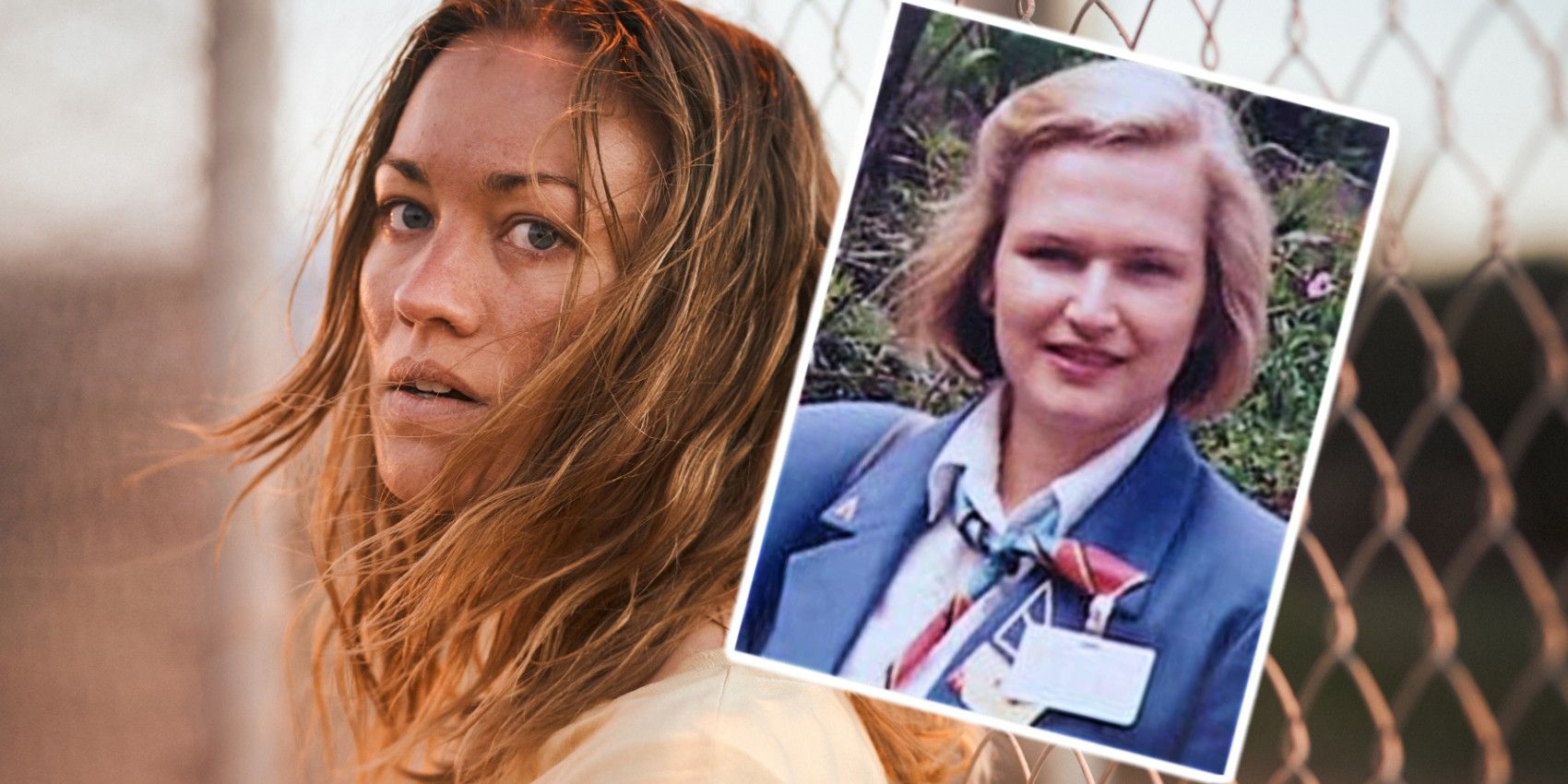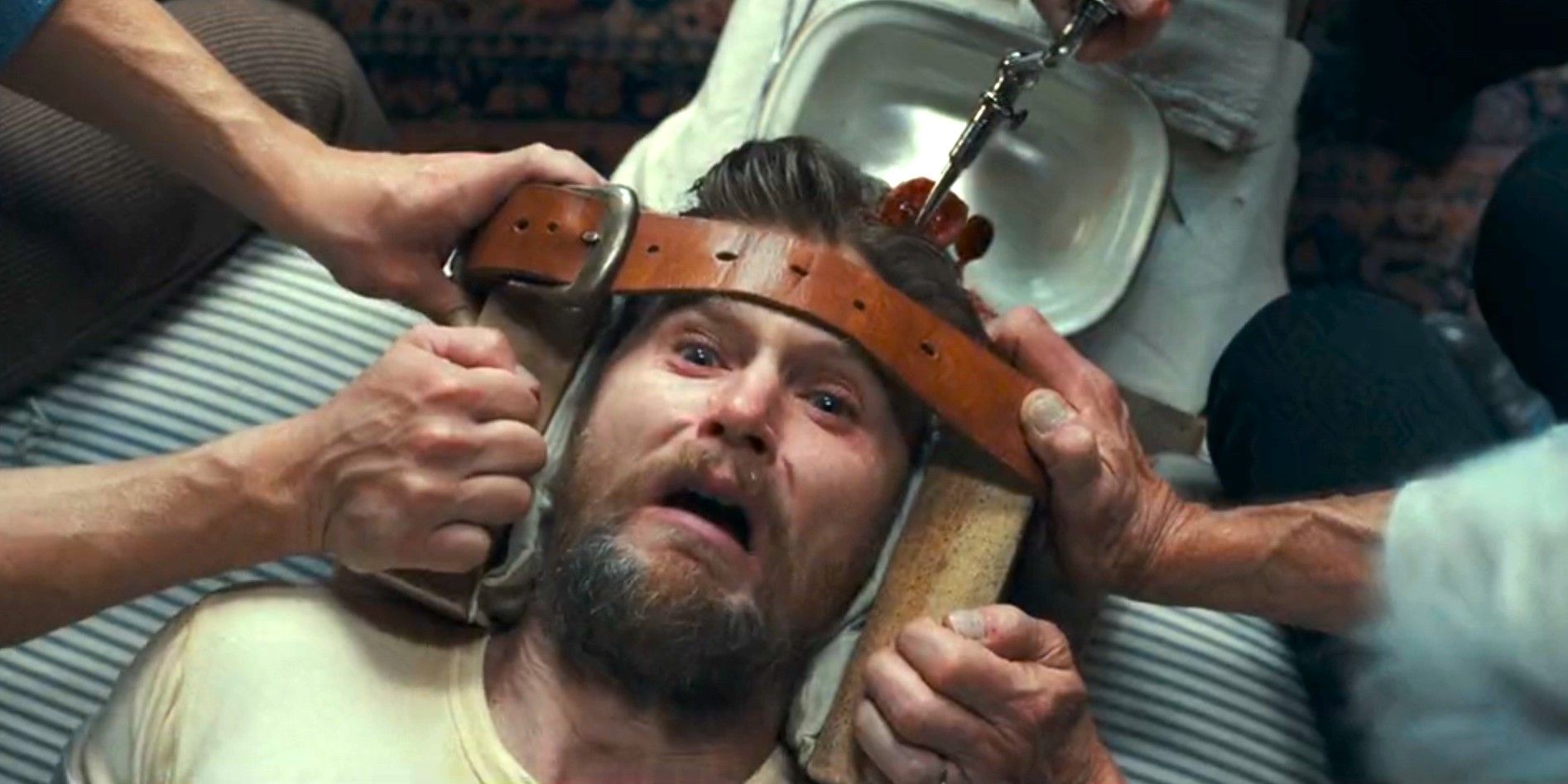Stateless True Story: What Happened To The Real Sofie Werner
Summary Ameer, Clare, and Cam showcase the failures of the immigration process and the cruelty in detention centers.
The depiction of Kenja Communications in Stateless is based on a real cult with dark practices.
Cornelia Rau's story highlights the flaws in Australia's mandatory detention policy and led to major changes.
Netflix's six-part drama miniseries Stateless is based on the shocking true story of an Australian woman diagnosed with schizophrenia spectrum disorder who was locked up in an Australian immigrant detention center after being mistaken for an undocumented non-citizen. The movie is based on the real-life experiences of 39-year-old flight attendant Cornelia Rau. Rau was first reported missing after disappearing from a psychiatric hospital in March 2004. She was rediscovered again in February 2005.
It was revealed that she'd spent months in a women's prison before being transferred to Baxter Immigration Reception and Processing Centre. Though Rau had been troubled in the past, her major psychological break came after her time spent in a cult called Kenja. Stateless stars Yvonne Strahovski as Sofie Werner, a fictional version of Rau. While Stateless is a dramatized version of events, it combines accounts of refugee experiences in Australia and the tragic details of Rau's incarceration is a mixture of fact and fiction.
Related 25 Genuinely Scary Crime Documentaries On Netflix Netflix has proven time and time again its good at making true-crime documentaries. But which ones are the scariest?
Ameer, Clare, And Cam Are (Mostly) Fictional
The Characters Were Examples Of Problems In Detention Centers
Episode Number Title Directed By 1 "The Circumstances in Which They Come" Emma Freeman 2 "Incognita" Emma Freeman 3 "The Right Thing" Emma Freeman 4 "Run Sofie Run" Jocelyn Moorhouse 5 "Panis Angelicus" Jocelyn Moorhouse 6 "The Seventh Circle" Jocelyn Moorhouse
Stateless has four main characters: Afghan refugee Ameer (Fayssal Bazzi), harried bureaucrat Clare (Asher Keddie), detention center guard Cam (Jai Courtney), and Sofie. The true story of Cornelia Rau's detention provides the main framework for the series. The other characters are based more broadly on stories of refugees and accounts of immigration detention centers, rather than on one particular person.
Ameer, Clare, and Cam represent different corners of how the immigration process can fail and exact cruelty on the people it's supposed to help. Ameer wants to start a new life in Australia the right way, but cannot keep his hands clean, forced to deal with people smugglers.
Cam views Korvo Security wages as "blood money," but his story shows how the job works to drain empathy and encourage the mistreatment of detainees. Clare believes she can do a better job than her predecessor, but finds herself in over her head and struggling to keep her conscience clear.
GOPA Is Based On A Real Cult
Kenja Communications
Cornelia Rau's ordeal was extensively covered in a report by Robert Manne (via The Monthly), which delves into the real-life version of GOPA. Gordon (Dominic West) and Pat Masters (Cate Blanchett) are based on a couple named Jan Hamilton and Ken Dyers, who founded a company called Kenja Communication in 1982. Much of GOPA's portrayal in Stateless is taken from accounts of Kenja's form of "therapy," which is based on a pseudo-science idea called Energy Conversion.
Kenja's high-cost workshops involve creative projects like dancing and singing in a search for one's inner child, but there's also a darker side to the group that has led to it being labeled a cult. Kenja is said to particularly prey on vulnerable young middle-class people and reportedly encourages them to sever ties with their friends and family.
According to Liberal parliamentarian Stephen Mutch, who investigated Kenja after his constituents came to him with concerns, the group requires recruits "to confess and write down their darkest secrets," so they can use these secrets to blackmail and silence them if they decide to leave. As seen in Stateless, Ken Dyers practiced Energy Conversion sessions where he would sit and maintain prolonged eye contact with members, supposedly to untangle and free them from their soul's deepest toxicities.
Kenja Communication leader Ken Dyres died by suicide following allegations of child sexual abuse.
Gordon's sexually abusive behavior in Stateless is also based on the real-life version of the character. Ken Dyers was said to have used his position of power within Kenja to have sex with recruits, both consensually and non-consensually. In 1993, he was charged with sexually abusing four girls between the ages of eight and 15 and was found guilty on one count of sexual abuse of a child. In 2005, Dyers was charged with the sexual abuse of two 12-year-old girls.
These are likely the charges alluded to in Stateless when a police officer recognizes a picture of Gordon Masters from a brochure and tells Margot (Marta Dusseldorp) that he can't give any information regarding an ongoing investigation. Before the charges could be brought to trial, Ken Dyers died by suicide by shooting himself in the head in July 2007. Kenja Comminiocation remains operational.
How The Real Sofie Werner Ended Up In Detention
The Police Detained Her As A Suspected
Close
The circumstances of Cornelia Rau's split from Kenja are said to have been very similar to what is depicted in Stateless, with the major difference being that there were several years between her departure from Kenja in 1998 and her imprisonment in 2004. According to an anonymous source who was at Kenja at the same time as Cornelia, Dyers "publicly berated her for failing to come up to his expectations" and Hamilton called her artistically talentless after the couple had initially given her "special attention and plenty of acknowledgment."
This caused a psychological break that resulted in odd behavior, such as "talking incoherently and staring into middle space." Cornelia was ejected from the group and told not to return, and found three days later driving on the wrong side of the road. What followed was several years in which her sister, Christine, said Cornelia's family, "watched [her] deteriorate into a secretive, suspicious, frightened and unpredictable person whose behavior was at times bizarre."
Related The 25 Best Documentaries On Netflix Right Now Netflix has many critically lauded documentaries to check out but the sheer number is overwhelming. Which are the best to check out first?
Cornelia first attempted to obtain a German passport in 2003 and was placed by her family in a psychiatric facility in 2004. On March 17, she left the hospital ahead of her planned release and emptied her bank account. A couple of weeks later, she was found sitting by the side of the road, and a police officer was called. Cornelia offered conflicting stories about her identity, alternately saying her name was either Anna Schmidt or Anna Brotmeyer, and claiming to be a German citizen who had made her way to Australia illegally.
The police officer detained her as a suspected UNC - and it was at that point that she fell into the legal trap that led her to prison and, later, to Baxter Detention Center. As Manne explains:
"On the basis of a High Court decision of 2003, in the al-Kateb case, even if Cornelia Rau was willing to leave Australia – as indeed she most certainly was – in the absence of a country willing to offer her a visa she could be lawfully detained for the remainder of her life. Or, as the government solicitor put it in the relevant case, until Hell itself froze over. Although the government’s thinking was full of legal holes, it was the combination of sections 189 and 196 of the Migration Act and the government’s victory in the al-Kateb case that provided the foundation for Cornelia’s ten-month detention."
This is the problem highlighted by Stateless. Because the UNCs at Baxter (called Barton in the series) are not Australian citizens, they do not have any of the rights to due legal process afforded to citizens. Because they are officially in administrative detention rather than prison, they can theoretically be detained for the rest of their lives. Moreover, the Department of Immigration and Multicultural and Indigenous Affairs (DIMIA) is inclined to disbelieve asylum seekers and search for any inconsistencies in their stories.
Because this rigorous search for inconsistencies is based on the assumption that asylum seekers don't want to be returned to their countries of origin, the response to Cornelia's obvious lies about her identity was, despite her pleas to be sent to Germany, to continue holding her at the detention center.
Cornelia Rau's Time In Immigration Detention
Cornelia Rau Spent More Time In Prison
Unlike Sofie, who spent the entirety of her detainment at the immigration detention center, Cornelia Rau spent most of her time imprisoned in Brisbane Women's Correctional Center. There, she exhibited strange and erratic behavior, such as pacing around the tennis court for hours on end until she had to be physically removed, and hoarding food in her cell. Rather than being given psychiatric treatment, she was punished for this behavior by being frequently placed in solitary confinement in the Detention Unit.
The majority of the detainees had been imprisoned in detention centers for years and were suffering from depression...
She was finally transferred to Baxter in October 2004. At Baxter, mental illness was common. The majority of the detainees had been imprisoned in detention centers for years and were suffering from depression, which was treated with powerful anti-depressants that left them struggling to function (as Ameer experiences). Psychiatrist Dr. Howard Gorton, who worked at Baxter, said of his experiences there:
“The people I saw and treated at Baxter were the most damaged people I’ve seen in my whole psychiatric career. Up until that time, I’d never met an adult-onset bed-wetter. I’d never met someone with psychological blindness. And there were also a few physically crippled people who believed they were unable to walk, and this was probably psychological too.”
Unlike most of the detainees at Baxter, however, Cornelia's mental illness manifested as mania rather than depression. Manne recounts:
"Anna was in the grip of a florid psychosis. She paced frantically; she stared blankly; she sat in the dirt; she had dispensed with personal hygiene; she had lost all inhibition and modesty; often she cried; sometimes she screamed; she was gentle with fellow detainees but often verbally and physically aggressive with the guards. Most inmates and regular visitors to Baxter recognized, almost at a glance, that there was something very seriously wrong with Anna."
As depicted in Stateless, a psychiatrist who assessed "Anna" on November 6, 2004, found reason to believe that she was suffering from schizophrenia and recommended she be sent for outside assessment. This did not happen. Six weeks later, Baxter's psychologist, Dr. Adam Micallef again reached out to a local psychiatric hospital in the hope of having Anna admitted. They declined to do so since asylum seekers were considered to be too much trouble.
Your browser does not support the video tag.
How Cornelia Rau's Real Identity Was Discovered
Cornelia Rau Drew Attention From Advocates
Unlike in Stateless, where Sofie manages to avoid attracting outside attention during her time at Barton, Cornelia Rau's severely disordered behavior and the lack of care she was given drew concern from advocates. One of these advocates, Pamela Curr, began campaigning on Anna's behalf, and on January 31 the story of the severely mentally ill German woman locked up in an immigration detention center finally made it to the press.
It was accompanied by a photo of "Anna" - the only picture that had been publicly made available since she was originally detained since DIMIA had made no efforts to use the media to search for her real identity. The photo was seen by a family friend, who passed it along to the Raus.
Cornelia Rau was removed from Baxter on February 4, 2005 - 10 months after she was detained.
The circumstances of Cornelia's release were slightly less dramatic than what's seen in Stateless. Cornelia's mother, Veronika, contacted the local police, who contacted Baxter Detention Center, who emailed a photo of "Anna" that was passed back to her parents. Once her identity was confirmed, on February 3, Cornelia was released the following day in great haste. As she recalled:
"I was suddenly transported to a mental institution and the circumstances were very strange. About five people in large clothing came into my room at night while I was having a shower and I hardly had a chance to turn off the tap. I was nude and hardly could get something on to cover myself. They were harsh and forceful. Then they slipped me onto an ambulance stretcher-bed. It was so foul. I didn’t know what was going on."
The reason for the rush was that DIMIA was aware that the story of Cornelia Rau was about to break in the media, and they wanted to make absolutely sure that she was no longer a detainee by the time she made it to the headlines. However, this did little to mitigate the bad press that followed.
Fallout From The Cornelia Rau Scandal
It Led To A Major Investigation
The story of Cornelia Rau's detention was an instant media firestorm, which led to a light being shone on the wider ugliness of Australia's mandatory detention policy. Several days after the story made headlines, Australian Federal Police Commissioner Mick Palmer launched an inquiry into Rau's almost year-long imprisonment. This was later expanded to include the case of Vivian Solon, an Australian woman who was wrongfully deported to the Philippines in 2001.
The report was tabled in July 2005 and an apology was issued to both Rau and Colon, with Rau later receiving compensation of A$2.6 million. Though it may have been a white Australian woman who got the media's attention, the scandal also brought progress for other Baxter detainees. Peter Qasim - who held the record for being the longest-serving immigration detainee in Australia, and is likely the basis for the "Suitcase Man" in Stateless - was released in July 2005 and granted a bridging visa.
More than two hundred other cases of wrongful detention were discovered in the wake of Rau's release.
More than two hundred other cases of wrongful detention were discovered in the wake of Rau's release. More damningly, Palmer's report exposed a fundamental problem with the immigration department and its staffing. In what Palmer described as "assumption culture," people who were locked up (like Cornelia) were assumed to have been locked up legally, and remained locked up based on that assumption. As Manne summarizes it:
"In the history of the Australian Commonwealth, there has never been a more devastating assessment of the work of a major department of state than the one contained in the Palmer report."
Baxter Immigration Reception and Processing Centre was permanently closed in 2007. By the time its closure was announced, only 12 inmates remained out of the hundreds that had been there during Rau's incarceration.
The Latest News On Cornelia Rau
Rau Finally Traveled Abroad But Got Into More Trouble
In 2008, the government awarded Cornelia Rau $2.6 million in retribution for the detainment. That same year, Rau was allowed to travel but ended up detained at a Hamburg hospital for seven weeks. In 2009. she got in trouble again when she acted "erratically" in Jordan (via The Sydney Morning Herald). Through it all, the Australian Department of Foreign Affairs says Australian authorities said it would provide her aid. She finally returned to Australia in 2009 and was taken to a hospital with her nurse and guardian.
Since that time, Rau has mostly stayed out of the spotlight. According to her former attorney, Claire O'Connor, Rau now lives in South Wales. "She goes to classes, she takes part in the physical things she likes to do, swimming and sport," the attorney said (via ABC). "She's certainly in a better place than when she got out of detention."











COMMENTS